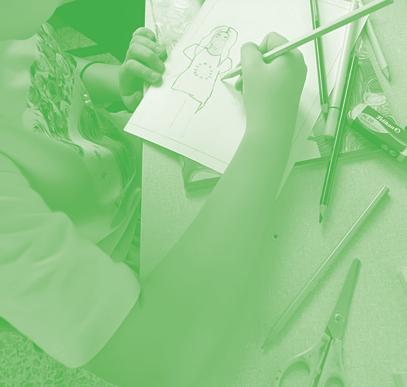
3 minute read
Culture4Kids Beyond the Textbook
Grainne Nugent, St Brigid's Primary School
Background
Advertisement
This project brought together 6 countries to explore the many facets of culture with a focus on activities that would engage children ‘Beyond the textbook' and classroom walls. This collaboration allowed pupils to share their experiences and to become aware of the importance of Europe's cultural heritage through education and informal learning.
Project Aims
The project aims to familiarise children with the cultures of the 6 partner countries through taking part in a variety of cross curricular activities. The objective is to utilise creative ideas including Art and ICT to engage pupils and teachers with the topic of Cultural Heritage. We hope that students gain an appreciation of traditions and culture in their own countries and that of others. As well as this, we hope to increase ICT skills including communicating and collaborating with others. We hope to use gamification of learning to engage our learners and motivate our staff cohort also.
Project Work
Teachers planned out their topics for the year based on the culture theme and linked them in a way that suited their own class level. Gaeilge was introduced into the project at all levels as well as Drama, English, Music and Art. We created a magazine about UNESCO sites in each country and taught the children about the importance of the UNESCO programme in preserving cultural sites. Each partner school created the Story of my Town to share with the others and shared their Christmas and Easter Customs both virtually and through posting various items. A recipe book was also created with each partner country trying out another recipe from a different country. This aspect was created during a European lockdown so provided huge motivation for the children involved. Upon returning to classrooms after initial lockdown we created a collaborative 'Jerusealema' video where we celebrated our return to school.
Outcomes
Pupils developed many skills and competencies. Researching correctly and filtering incorrect information on the internet was something they learned that they were not competent at before. Digital skills were improved by activities such as creating digital books and recording audio books. Critical thinking was also evident within the crafts activities as they used mediums, they were not familiar with previously. Pupils improved their teamwork, communication skills and collaboration within their own class and their partners in other schools.
National Quality Label
St Brigid's Primary School
Cecelia Gavigan, Balbriggan Educate Together
Background
This project brought together students from different countries to celebrate The European Day of Languages on the 26th of September.
Project Aim
The main aim of this project was to raise awareness of Europe’s rich linguistic diversity and encourage lifelong language learning in and out of school. It is our hope that students be exposed to new cultures and learn the alphabet of other European languages along with developing their creativity and learning about other European countries in an engaging way.
Project Work
The pupils created postcards for each partner school with a greeting in English and an additional language. Students were asked to design the postcards to represent what European Day of Languages means to them. We recorded videos to share with our partners and utilised various eTools to make the project engaging and to share information in innovative ways with our partners. When engaging with and responding to the work that our partners posted on the Twinspace, pupils were encouraged to consider how to give feedback in positive and respectful ways. Most of the work was conducted in class, but pupils also did some independent work along with work at home with their parents. When in class, we used pedagogies like whole class discussion, think-pair-share-square, small group work and one-to-one discussion. Finally, the physical outcomes of the project were used to create an eTwinning display on the corridor of the school to share our learning with the wider school community.
Outcomes
As a result of the project, the pupils became more interested in and increased their knowledge about the countries across Europe who had participated in the partnership. Pupils who were multilingual were given an opportunity to feel proud of their home languages. It was a beneficial learning experience for the pupils, not only in terms of cultivating a sense of European identity but also in encouraging the celebration of cultural and linguistic diversity, community integration and mutual understanding among members of the school.

National Quality Label










